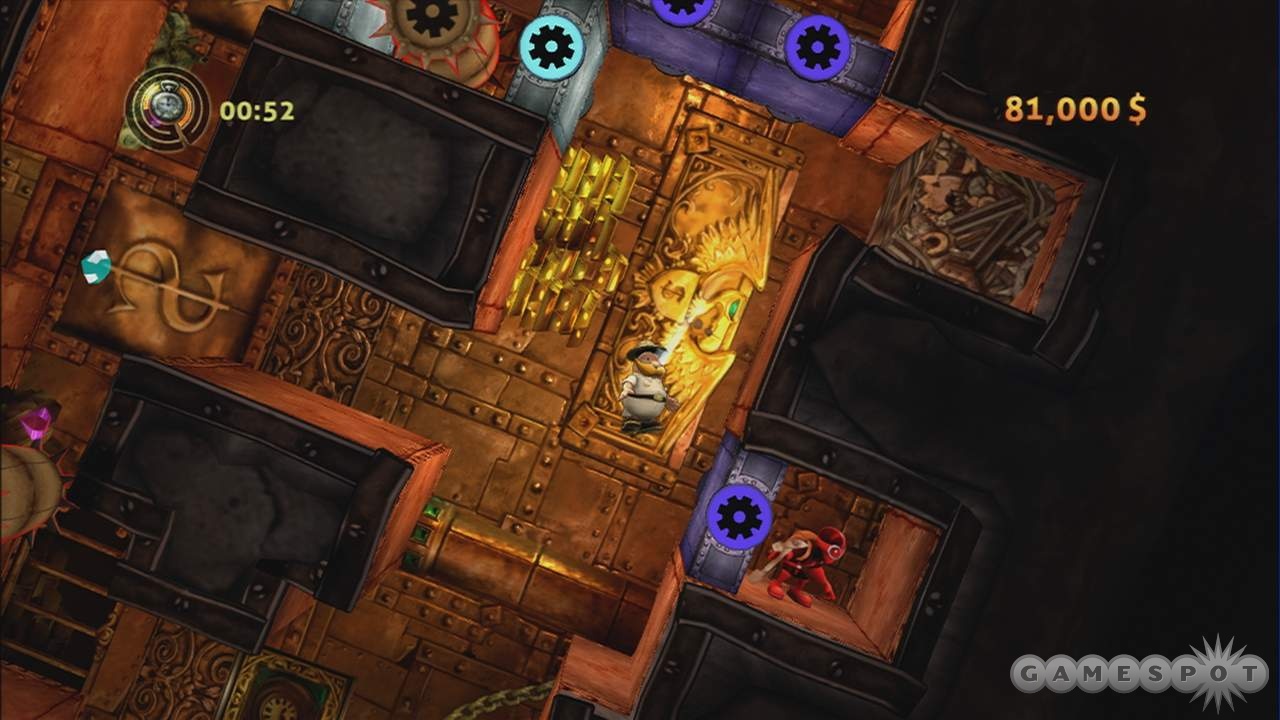Indiana Jones has been raiding tombs since 1981. Lara Croft got in on the action in 1996. Nathan Drake half-tucked his shirt and headed underground in 2007. And now, in 2010, it's Dr. Diggabone's turn. Other than his desire to locate lost relics, the rotund hero of Lazy Raiders has very little in common with his forebears. He doesn't have a gun, he's not athletic in the slightest, and he's too lazy to walk or run anywhere even when his life is threatened. He moves only when gravity dictates, and in this game of 75 mazelike levels, you can think of him as an oddly shaped ball that needs to collect treasures and avoid hazards en route to the exit. Lazy Raiders isn't a particularly challenging game, but its puzzles are fun to figure out and demand a deft touch with the analog stick.
After you opt to play either as the aforementioned archaeologist or as your avatar, Lazy Raiders' five tutorial levels do a great job of familiarizing you with the controls before dropping you into the game proper. You rotate the level using the left analog stick, flip the level vertically with a quick press of the A button, and that's it. Your primary goal in each level is simply to reach the golden pick axe so that you can dig through to the next level, but the path to the pick is rarely straightforward, and even when it is, there are other traps and treasures to consider before you leave. Lazy Raiders' 75 levels are divided up into groups of five, and every fifth level is a treasure room containing a valuable artifact. To access those rooms, you first need to collect a number of idols from the preceding levels, and in order for those idols to appear, you invariably have to fulfill other criteria, such as disabling all of the traps or collecting all of the liberally scattered gems in a level. This progression system works well because there's almost never any danger of being unable to pass a level, even if you're finding it impossible to collect all three of its idols. You're also encouraged to replay levels, both to collect more idols and to improve your rankings on online leaderboards.
Your score for each level is measured in dollars, and it's based on enough different factors that you always feel like you can improve in some way. You earn dollars for collecting gems and idols, for disabling traps, for forcing enemies into traps, and for exiting a level quickly, for example. You lose dollars anytime you take damage, so while Diggabone has infinite lives at his disposal, there's definitely an incentive to steer him clear of spike pits, flamethrowers, rotating saws, rolling boulders, and numerous other dangers. One of the neat things about the hazards in Lazy Raiders is that many of them can be used to cancel each other out, rendering even the deadliest levels safe to navigate. Dropping a boulder or a giant snowball into a spike pit fills the pit so that the spikes no longer protrude, for example, and bringing a flamethrower and a crate of TNT together results in an explosion that destroys them both. Similarly, any of these traps can be used to kill enemy bats and thieves who, like you, are slaves to gravity when the level is rotated.
The most surprising thing about Lazy Raiders is that even though your goal in every level is the same, it never feels overly repetitive. Level designs are diverse, and as you progress through the three different themed locales, new hazards and gameplay mechanics are introduced regularly. You don't have to contend with snowballs that get bigger when they roll over patches of snow until you reach the Arctic Wrecks levels, for example, and puzzles involving machinery and cogs (which double as dangerously spiky wheels when they're rolling around) don't show up until you arrive in the third and final Wild West area. The locale changes also add some much-needed variety to the visuals, which are detailed enough that you can derive some sadistic satisfaction from seeing Diggabone falling into traps or merely from great heights even when you have the camera zoomed out enough to see an entire level onscreen. The only reason you might ever feel the need to zoom in is if you lose sight of your hero after flipping a level, which can happen quite frequently in the Seven Cities of Gold treasure rooms, where the coloring is just a little too close to that of your explorer's outfit.

That outfit, incidentally, becomes available for your avatar to wear outside of the game as soon as you start playing, though you have to beat the final level of the game to unlock the matching hat. As in previous levels, reaching the golden pick in that level isn't terribly tough, but you need to have collected at least 175 of the 192 idols in the game to even play the last level, so don't be surprised if you get sent back to solve earlier puzzles upon reaching it. Fortunately, these levels are almost as much fun to replay as they are to play the first time through, because no matter how good you are with the analog stick, they're unlikely to ever play exactly the same way twice. It's conceivable that you could blaze through Lazy Raiders quickly enough that the asking price of 800 Microsoft points seems a bit steep, but if you take the time to savor and properly solve the majority of levels, you'll find no shortage of value here.